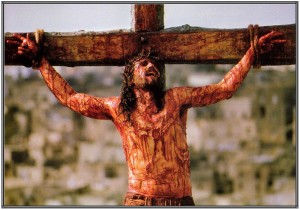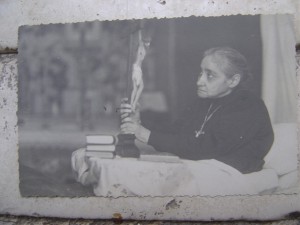FEAST OF THE MOST PRECIOUS BLOOD OF OUR LORD JESUS CHRIST

July 1 A.D. 2014 – The Most Precious Blood of Our Lord
Calendar for the Traditional Roman Rite
According to the Traditional Catholic Calendars of 1962 and previous, is the Feast of the Most Precious Blood of Our Lord Jesus Christ. After Vatican II, this Feast day was combined with Corpus Christi. In the 1969 Calendar, Corpus Christi is officially called the Solemnity of the Body and Blood of Christ. However, for those Catholics who like to follow the Traditional Calendar, today is a day to especially remember the price of our salvation – the Blood of Jesus Christ. Today we remember His blood spilt not only on the Cross but also in the Circumcision, Agony in the Garden of Gethsemane, Scourging at the Pillar of Flagellation, and the Crowning with Thorns.

Luisa’s prayer from the Hours of the Passion
O my Jesus Crucified, I adore your most precious Blood; I kiss your wounds one by one, intending to lavish in them all my love, my adorations, my most heartfelt reparations. May your Blood be for all souls, light in darkness, comfort in sufferings, strength in weakness, forgiveness in guilt, help in temptations, defense in dangers, support in death, and wings to carry them all from this earth up to Heaven.
Month of the Precious Blood
The month of July is dedicated to the Precious Blood. The feast of the Precious Blood of our Lord was instituted in 1849 by Pius IX, but the devotion is as old as Christianity. The early Fathers say that the Church was born from the pierced side of Christ, and that the sacraments were brought forth through His Blood.
“The Precious Blood which we worship is the Blood which the Savior shed for us on Calvary and reassumed at His glorious Resurrection; it is the Blood which courses through the veins of His risen, glorified, living body at the right hand of God the Father in heaven; it is the Blood made present on our altars by the words of Consecration; it is the Blood which merited sanctifying grace for us and through it washes and beautifies our soul and inaugurates the beginning of eternal life in it.”
The Old Testament

Cain and Abel are making an offering. Abel’s sacrifice is pleasing to God, Cain’s is not. This gives rise to the sin of hatred, and fratricide is its resolution. The thirsting earth soaks up Abel’s blood as it shouts to heaven for vengeance. This shouting prefigured the scene on Calvary, where Christ’s Blood cried to heaven for the redemption of mankind.
Millenia pass, and now we see Israel oppressed by Egypt. God commands the people to kill a lamb and to sprinkle the doorposts with its blood; houses thus besprinkled are spared by the messenger of death. But where the doors are not reddened with the blood of the lamb, all male firstborn from king to slave die. This blood on the doorposts was a type of the Blood of Christ. Can the blood of a lamb save a man? No, but as a figure of the Redeemer’s Blood it certainly does. For when the Destroyer sees the thresholds of a human heart marked with Christ’s sacred Blood, he must pass by. And another soul is saved.
In a vision the prophet Isaias saw a man treading out grapes (in the Orient, trampling upon grapes in the wine-press was the usual means of extracting the juice). The prophet asked the man: “Why are your garments so red? “The wine-press I have trodden alone,” he answers, “because from the nations there is no one with me.” The trodder of the wine-press is Christ, His garments crimsoned by the Blood of redemption.
Excerpted from The Church’s Year of Grace , Pius Parsch
The New Testament

The Church reminds us of the first drops of blood that flowed for our redemption on the day when Jesus was circumcised.
It is night on Mount Olivet, and the moon is shining. We see the holy face crimsoned with blood during the agony in the garden.
Unhappy, despairing Judas casts the blood-money down in the temple. “I have betrayed innocent blood!”
In the scourging chamber we see the Lord in deepest humiliation; under raw strokes the divine Blood spurts out over the floor. Christ is led before Pilate. Pilate shows the blood-covered Body to the crowds: Ecce homo! We go through Jerusalem’s streets following the bloody footsteps to Golgotha. Down the beams of the Cross blood trickles. A soldier opens the sacred side. Water and Blood.
Excerpted from The Church’s Year of Grace , Pius Parsch
Symbols of the Precious Blood

Adam is sleeping an ecstatic sleep. God opens his side, removes a rib and forms Eve, the mother of all the living. But our view transcends this action and in spirit we behold the second, the divine Adam, Christ. He is sleeping the sleep of death. From His opened side blood and water flow, symbols of baptism and the Eucharist, symbols of the second Eve, the Church, the Mother of all the living. Through blood and water Christ willed to redeem God’s many children and to lead them to an eternal home.
At Jerusalem a service in Yahweh’s honor is taking place on the Day of Atonement. The high priest is making his annual entrance into the holy of holies to sprinkle the blood of bucks and bulls upon the covenant in expiation for the sins of the people. The Church shows us the higher meaning of this rite. Our divine High Priest Christ on the first Good Friday entered that Holy of Holies which is not made with hands nor sprinkled with the blood of bucks and bulls; there He effects, once and for all, with His own Blood man’s eternal redemption.
A finale. Holy Church transports us to the end. The heavenly liturgy is in progress. Upon the altar is the Lamb, slain yet alive, crimsoned by His own Blood. Round about stand the countless army of the redeemed in garments washed white in the Blood of the Lamb. Hosts of the blessed are singing the new canticle of redemption: “You have redeemed us out of every tribe and tongue and nation by Your Blood.”
Now from vision to present reality. How fortunate we are to have divine Blood so near to us, to offer it to the heavenly Father for the sins of the whole world!
Excerpted from The Church’s Year of Grace , Pius Parsch
Devotion to the Precious Blood
Devotion to the Precious Blood is not a spiritual option, it is a spiritual obligation, and that not only for priests, but for every follower of Christ. I really believe that one of the symptoms of modern society (and I would even include, sadly, modern Catholic society) one of the symptoms of a growing, gnawing secularism is the lessening and the weakening of devotion to the Precious Blood. Devotion, as we know, is a composite of three elements: It is first- veneration, it is secondly- invocation, and it is thirdly- imitation. In other words, devotion to the Precious Blood of Christ, the Lamb of God who was slain, is first of all to be veneration on our part, which is a composite of knowledge, love and adoration. We are to study to come to a deeper understanding of what those two casual words, Precious Blood, really mean.
I found this passage in the oldest document, outside of sacred scripture, from the first century of the Christian era – to be exact, from Pope St. Clement I, dated about 96 A.D. Says Pope Clement: “Let us fix our gaze on the Blood of Christ and realize how truly precious It is, seeing that it was poured out for our salvation and brought the grace of conversion to the whole world.”
To understand the meaning of the Precious Blood we must get some comprehension of the gravity of sin, of the awfulness of offending God, because it required the Blood of the Son of God to forgive that sin. We are living in an age in which to sin has become fashionable.
This veneration of the Precious Blood, which is the first element in our devotion to the Precious Blood means that we have a deep sensitivity to the awfulness of sin. Sin must be terrible. It must be awful. It must be the most dreadful thing in the universe. Why? Because it cost the living God in human form the shedding of His Blood.
Lord Jesus, You became Man in order by your Passion and Death and the draining of your Blood on the Cross, might prove to us how much You, our God, love us. Protect us, dear Jesus, from ever running away from the sight of blood. Strengthen our weak human wills so that we will not only not run away from the cross, but welcome every opportunity to shed our blood in spirit in union with your Precious Blood, so that, dying to ourselves in time we might live with You in Eternity. Amen
Permanent link to this article: https://luisapiccarreta.com/feast-of-the-most-precious-blood-of-our-lord-jesus-christ/





